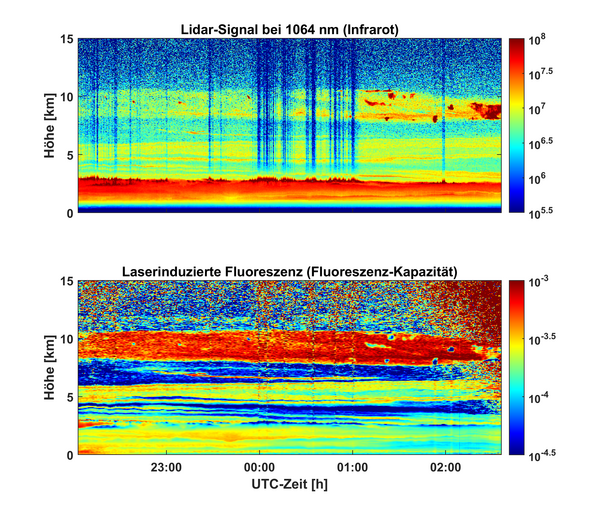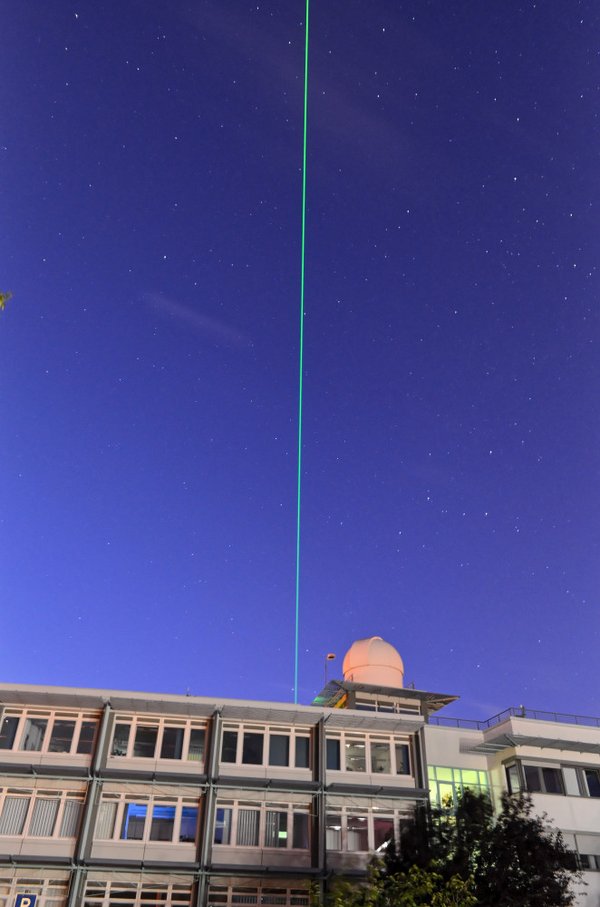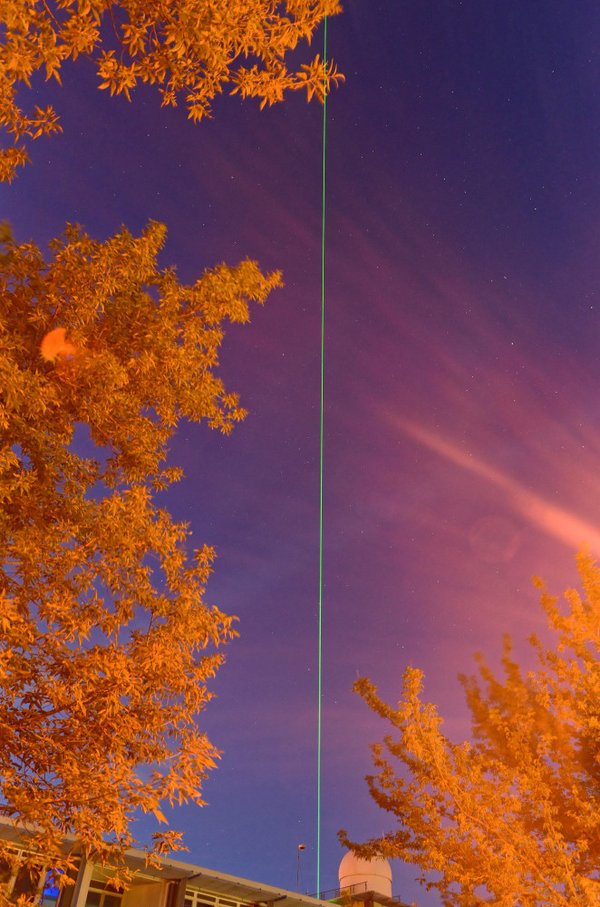Fluorescent light reveals invisible smoke at high altitudes - as currently from Canadian wildfires across Europe
Leipzig,
04.06.2025
Forest fires could have a greater impact on clouds and climate than previously assumed
Leipzig. The fluorescence lidar technology does not only enable a better determination of the origin of particles in the atmosphere. The method can also visualise particle layers that were previously practically invisible. This is the conclusion drawn by a team from the Leibniz Institute for Tropospheric Research (TROPOS) from the evaluation of 250 hours of lidar measurements over Leipzig in 2022 and 2023. The researchers had repeatedly observed very thin layers of smoke at high altitudes, which originated from forest fires in Canada but could not be seen using conventional methods. This suggests that the upper troposphere over Europe may be more polluted than previously assumed, especially during the summer forest fire season, the research team writes in the journal Atmospheric Chemistry and Physics. The observations suggest that thin layers of smoke can favour the formation of ice clouds. The fluorescence method offers great opportunities for a more detailed investigation of such interactions between aerosols and clouds.
The measurements in Leipzig are once again showing wildfire smoke from Canada. This smoke is therefore not only visible on satellite images, but can now be analysed in more detail using fluorescence lidar technology.
Aerosol particles influence the Earth's energy and water balance: they scatter and absorb radiation and thus influence the energy balance on a global scale. By acting as cloud condensation nuclei (CCN) or ice nucleating particles (INPs), these particles can influence the microphysical properties of clouds and make them more or less reflective. Whether the droplet around a particle in a cloud remains liquid or freezes strongly changes the climatic effect of this cloud. Recent studies indicate that the heterogeneous freezing in high ice clouds, especially by smoke particles from large forest fires, still needs to be investigated in more detail.
One approach to this is lidar devices that use lasers to observe aerosols and clouds remotely from the ground or from satellites. This is also the case in Leipzig: MARTHA ("Multiwavelength Atmospheric Raman Lidar for Temperature, Humidity, and Aerosol Profiling") is the largest and oldest lidar at TROPOS in Leipzig. It emits laser light at three wavelengths (355, 532 and 1064 nanometres) and collects the backscattered light with a large primary mirror with a diameter of 80 centimetres. In the receiver, this laser light backscattered by the particles in the atmosphere is analysed by sorting it according to different wavelengths using precise optics: Based on the polarisation (rotation) and the different scattering behaviour at the various laser wavelengths, the type of particle can be deduced. However, it is still difficult to differentiate between smoke and volcanic sulphates in high layers and between smoke and urban pollution in low layers, as the typical value ranges for polarisation, backscattering and absorption efficiency of the different particle types overlap. These gaps can now be closed by fluorescence. This makes use of the effect that molecules can glow at longer wavelengths after laser irradiation, similar to the way certain substances do in the UV light of a discotheque. The first modern multi-channel atmospheric lidar system with fluorescence technology was implemented at the Lindenberg Observatory of the German Weather Service (DWD) over a decade ago. Since then, various research groups around the world have been working on further developing this technology.
In August 2022, the MARTHA system in Leipzig received an additional receiver channel that can measure fluorescence backscattering. This uses an interference filter centred at 466 nanometres to filter out a part of the fluorescence spectrum of aerosol particles. Due to the large bandwidth of the fluorescence channel and the low intensity of the fluorescence signal, measurements are only possible at night. During the day, the scattered solar radiation would cause too much noise in the fluorescence channel. As the MARTHA system is operated manually, the number of measurements is limited: From August 2022 to October 2023, around 50 measurements were carried out, yielding more than 250 hours of atmospheric fluorescence observations. The results have now been published. The researchers focused on four case studies:
In the spring and summer of 2023, huge forest fires raged across Canada, particularly in the provinces of Alberta and British Columbia. The prevailing westerly winds transported large quantities of forest fire smoke from the burnt biomass to Europe. As a result, the researchers frequently observed layers of smoke from forest fires over Leipzig from mid-May to September 2023, for example on 4 and 5 July 2023. On this night, an over 2 km thick layer of smoke extended in the atmosphere over Leipzig, which was characterised by particularly strong fluorescence. "In addition to the importance for the identification of aerosol types, our results indicate another capability of the fluorescence lidar technique: the detection of optically thin aerosol layers. In several measurements with the new fluorescence channel, an increased fluorescence signal indicated the presence of aerosol layers that went unnoticed when the previous standard technique was used exclusively," reports Benedikt Gast from TROPOS.
This was particularly impressive on 21 September 2022: using conventional methods, the upper troposphere appeared to be fairly clean. Only the polluted boundary layer near the ground and a few thin layers up to 4 kilometres height indicated aerosol. "However, an increased fluorescence backscatter coefficient revealed several other fluorescent aerosol structures throughout the middle and upper troposphere at about 5, 7, 9 and 10 km altitude. The higher layers would probably not have been recognised as aerosol layers without the additional fluorescence information. This demonstrates that with fluorescence measurements such thin aerosol layers can be more easily identified from the preview images and selected for detailed analysis," emphasises Dr Cristofer Jimenez from TROPOS.
Due to their low optical thickness, such thin, very high aerosol layers may not have a relevant direct radiative effect, but the particles they contain could influence cloud formation, e.g., by acting as ice nucleating particles. In both examples, the measurements of the fluorescence backscatter coefficient characterised thin layers of forest fire smoke at relatively high altitudes around the tropopause. This altitude range is often a suitable location for the formation of cirrus clouds. The relevance of smoke particles to act as INPs is still being discussed in research. Until now, forest fire smoke has been considered rather inefficient at temperatures above -30 °C compared to other aerosol types such as mineral dust. The new observations now give reason to further investigate the possible effect of smoke particles as INPs for the formation of cirrus clouds.
This is because several observations showed cirrus clouds directly below layers of smoke. One example is the measurement taken on the night of 29/30 May 2023. According to the researchers, this is the first time that the effect of optically thin smoke layers on cirrus clouds has been investigated using fluorescence.
At the beginning of the measurement, parts of the cirrus clouds were even embedded in the smoke layer. As pure water or even the small ice crystals in cirrus clouds do not fluoresce, the fluorescence technique can also be used to detect aerosol particles within the cloud. The height profile of the fluorescence backscattering, a small number of ice crystals as well as the arrangement of the smoke and cloud layer and their temporal progression indicate that the smoke particles could have triggered the cloud formation by serving as ice nucleating particles.
Summary and outlook:
The Leipzig measurements of 2022/23 showed that optically thin layers of smoke invisible to conventional lidar systems occur more frequently than previously thought at high altitudes. This suggests that the atmosphere over Europe may be more polluted than previously thought, especially during the summer forest fire season. Even if these thin layers do not have a major direct impact on incident sunlight, smoke particles at these altitudes could become an additional source of clouds in an otherwise relatively clean atmosphere and then have an impact on incident sunlight and thus the climate on the ground. The investigation of such aerosol layers with fluorescence lidars could provide more clarity. Several observations of cirrus clouds directly below smoke layers indicate that this smoke could be the primary source of ice nuclei in such cases and that heterogeneous freezing is the dominant process. To explore this possible aerosol-cloud effect in more detail, a larger data set would be beneficial and could provide stronger evidence and more detailed insights into this hypothesis.
The MARTHA system at TROPOS in Leipzig has therefore been undergoing fundamental modernisation since the end of 2023. Thanks to funding from the Free State of Saxony, a new, even more powerful laser and a 32-channel spectrometer have been purchased, enabling detailed aerosol measurements from the ground to the stratosphere. "This will allow us to precisely document all trends in the climate system - caused by forest fire aerosol and volcanic aerosol in the upper troposphere and lower stratosphere - over Saxony and Central Europe in the coming decades," explains Albert Ansmann from TROPOS. The fluorescence lidar technology is a crucial tool for this ambitious scientific objective due to the special sensitivity for smoke from forest fires that has now been published.
The knowledge gained using the new fluorescence technology forms an important basis for the Leibniz ScienceCampus 'BioSmoke', which was launched in autumn 2024 - a research network in Leipzig funded by the Leibniz Association that is investigating the effects of smoke aerosol and biogenic particles on the atmosphere under the leadership of TROPOS together with Leipzig University, the German Biomass Research Centre and the Helmholtz Centre for Environmental Research (UFZ). A large part of the research questions addressed within the framework of 'BioSmoke' deal directly or indirectly with the fluorescence measurements of the MARTHA lidar in order to learn more about the emission, transport and interaction of smoke with atmospheric processes.
Tilo Arnhold
Publication:
Gast, B., Jimenez, C., Ansmann, A., Haarig, M., Engelmann, R., Fritzsch, F., Floutsi, A. A., Griesche, H., Ohneiser, K., Hofer, J., Radenz, M., Baars, H., Seifert, P., and Wandinger, U.: Invisible aerosol layers: improved lidar detection capabilities by means of laser-induced aerosol fluorescence, Atmos. Chem. Phys., 25, 3995-4011, https://doi.org/10.5194/acp-25-3995-2025 , 2025.
The research was funded by the Federal Ministry of Education and Research (BMBF) as part of the FONA strategy "Research for Sustainability" (funding code 01LK2001A), by the Free State of Saxony from tax revenues on the basis of the budget approved by the Saxon State Parliament (Sächsische Aufbaubank: grant no. 100669383) and the Leibniz Association as part of the Leibniz ScienceCampus "Smoke and bioaerosols in a changing climate" (BioSmoke) (project number W86/2023).
Contacts for the media:
Benedikt Gast / Dr Cristofer Jimenez
Research Associate, Remote Sensing of Atmospheric Processes (RSD), Leibniz Institute for Tropospheric Research (TROPOS), Leipzig
Phone +49-341-2717- 7462, - 7368
https://www.tropos.de/institut/ueber-uns/mitarbeitende/cristofer-jimenez
and
Dr Albert Ansmann
Department of Remote Sensing of Atmospheric Processes (RSD), Leibniz Institute for Tropospheric Research (TROPOS), Leipzig
Phone +49-341-2717-7064
https://www.tropos.de/institut/ueber-uns/mitarbeitende/albert-ansmann
or
Tilo Arnhold, TROPOS Public Relations
Phone +49 341 2717-7189
http://www.tropos.de/aktuelles/pressemitteilungen/
Further information and links:
New Leibniz Science Campus researches forest fires and climate (press release, 20/03/2024):
https://www.tropos.de/aktuelles/pressemitteilungen/details/neuer-leibniz-wissenschaftscampus-erforscht-waldbraende-und-klima
https://www.leibniz-gemeinschaft.de/forschung/leibniz-wissenschaftscampi/rauch-und-bioaerosole-im-klimawandel
Smoke from Canadian forest fires has been hovering over Germany for weeks. (Press release, 29/06/2023):
https://www.tropos.de/aktuelles/pressemitteilungen/details/rauch-von-kanadischen-waldbraenden-schwebt-seit-wochen-ueber-deutschland
The Leibniz Institute for Tropospheric Research (TROPOS) is a member of the Leibniz Association, which brings together 96 independent research institutions. Its focus ranges from the natural sciences, engineering and environmental sciences to economics, spatial and social sciences and the humanities. Leibniz Institutes are dedicated to socially, economically and ecologically relevant issues.
They conduct knowledge- and application-oriented research, including in the overarching Leibniz Research Alliances, are or maintain scientific infrastructures and offer research-based services. The Leibniz Association focuses on knowledge transfer, especially with the Leibniz Research Museums. It advises and informs politics, science, business and the public.
Leibniz institutions maintain close cooperation with universities - including in the form of the Leibniz ScienceCampi, with industry and other partners in Germany and abroad. They are subject to a transparent and independent review process. Due to their national importance, the federal and state governments jointly fund the institutes of the Leibniz Association. The Leibniz Institutes employ around 21,300 people, including 12,200 scientists.
The financial volume amounts to 2.2 billion euros. They are financed jointly by the federal and state governments. The basic funding of the Leibniz Institute for Tropospheric Research (TROPOS) is provided by the Federal Ministry of Education and Research (BMBF) and the Saxon State Ministry of Science and the Arts (SMWK). The institute is co-financed by tax revenue on the basis of the budget approved by the Saxon State Parliament.
http://www.leibniz-gemeinschaft.de
https://www.bmbf.de/
https://www.smwk.sachsen.de/




